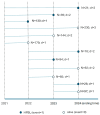Prolonged Overtime Predicts Worsening Burnout Among Healthcare Workers: A 4-Year Longitudinal Study in Taiwan
- PMID: 40805892
- PMCID: PMC12345989
- DOI: 10.3390/healthcare13151859
Prolonged Overtime Predicts Worsening Burnout Among Healthcare Workers: A 4-Year Longitudinal Study in Taiwan
Abstract
Background: Overtime adversely affects physical and mental health, contributing to irritability, anxiety, reduced sleep, and even cardiovascular issues, ultimately lowering care quality and increasing turnover intentions. This study aimed to investigate whether prolonged overtime increases the risk of occupational burnout over time among healthcare workers. Methods: We conducted a four-year longitudinal observational study using secondary data from annual surveys (2021-2024) of healthcare workers at a medical university hospital in Taichung, Taiwan. Burnout was assessed using the personal burnout (PB) scale from the Copenhagen Burnout Inventory (CBI), with high PB levels (HPBL) defined as scores in the upper quartile of the 2021 baseline. Survival analysis utilizing the Kaplan-Meier method and Cox regression investigated burnout progression and the effects of overtime. Results: HPBL was defined as PB scores ≥45.83 (upper quartile in 2021). The proportions of HPBL were 30.28% (2021), 33.29% (2022), 36.75% (2023), and 32.51% (2024). Survival analysis confirmed that the risk of burnout increased over time, with the survival time estimated at 2.50 ± 0.03 years and lower survival probabilities observed among participants working overtime (Log-rank test, p < 0.0001). Multivariate logistics revealed overtime work, female gender, being a physician/nurse, and reduced sleep as independent risk factors for HPBL (OR = 3.14 for overtime, p < 0.001). These findings support the hypotheses on burnout progression and the impact of overtime. Conclusions: Overtime significantly heightens the risk of burnout, which worsens over time. Female sex, healthcare roles, obesity, and insufficient sleep are additional risk factors. Limiting overtime and proactive interventions are crucial to preventing burnout in healthcare workers.
Keywords: burnout; healthcare workers; longitudinal study; overtime; survival analysis.
Conflict of interest statement
The authors declare no conflict of interest.
Figures



Similar articles
-
Prescription of Controlled Substances: Benefits and Risks.2025 Jul 6. In: StatPearls [Internet]. Treasure Island (FL): StatPearls Publishing; 2025 Jan–. 2025 Jul 6. In: StatPearls [Internet]. Treasure Island (FL): StatPearls Publishing; 2025 Jan–. PMID: 30726003 Free Books & Documents.
-
Common antecedents and outcomes of burnout among healthcare workers in the Emergency Department: A scoping review.Am J Emerg Med. 2025 Jun 21;96:140-150. doi: 10.1016/j.ajem.2025.06.039. Online ahead of print. Am J Emerg Med. 2025. PMID: 40570489 Review.
-
Investigation and analysis of mental health status of the older adult in western rural areas.Front Public Health. 2025 Jul 16;13:1612600. doi: 10.3389/fpubh.2025.1612600. eCollection 2025. Front Public Health. 2025. PMID: 40740371 Free PMC article.
-
Sexual Harassment and Prevention Training.2024 Mar 29. In: StatPearls [Internet]. Treasure Island (FL): StatPearls Publishing; 2025 Jan–. 2024 Mar 29. In: StatPearls [Internet]. Treasure Island (FL): StatPearls Publishing; 2025 Jan–. PMID: 36508513 Free Books & Documents.
-
Preventing occupational stress in healthcare workers.Cochrane Database Syst Rev. 2014 Dec 8;(12):CD002892. doi: 10.1002/14651858.CD002892.pub4. Cochrane Database Syst Rev. 2014. Update in: Cochrane Database Syst Rev. 2015 Apr 07;(4):CD002892. doi: 10.1002/14651858.CD002892.pub5. PMID: 25482522 Updated.
References
-
- Canu I.G., Marca S.C., Dell’Oro F., Balázs Á., Bergamaschi E., Besse C., Bianchi R., Bislimovska J., Bjelajac A.K., Bugge M., et al. Harmonized definition of occupational burnout: A systematic review, semantic analysis, and Delphi consensus in 29 countries. Scand. J. Work Environ Health. 2021;47:95–107. doi: 10.5271/sjweh.3935. - DOI - PMC - PubMed
-
- Freudenberger H.J. Job Stress and Burnout. Sage; Beverly Hills, CA, USA: 1982. Counseling and dynamics: Treating the end-stage person; pp. 173–186.
-
- Grossi G., Perski A., Osika W., Savic I. Stress-related exhaustion disorder—Clinical manifestation of burnout? A review of assessment methods, sleep impairments, cognitive disturbances, and neuro-biological and physiological changes in clinical burnout. Scand. J. Psychol. 2015;56:626–636. doi: 10.1111/sjop.12251. - DOI - PubMed
Grants and funding
LinkOut - more resources
Full Text Sources

